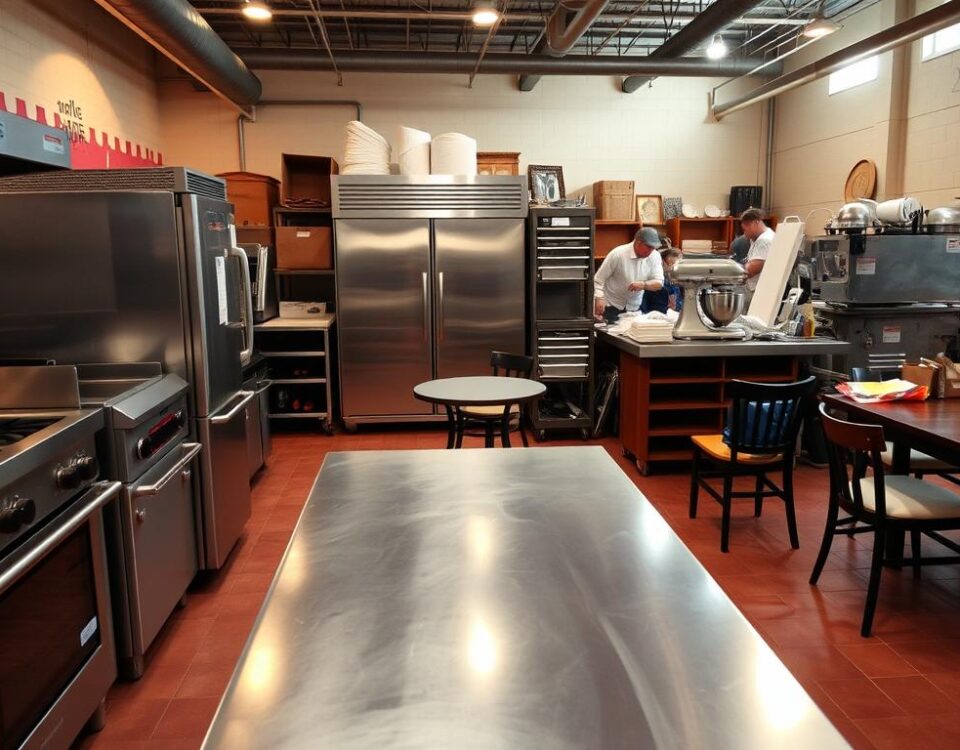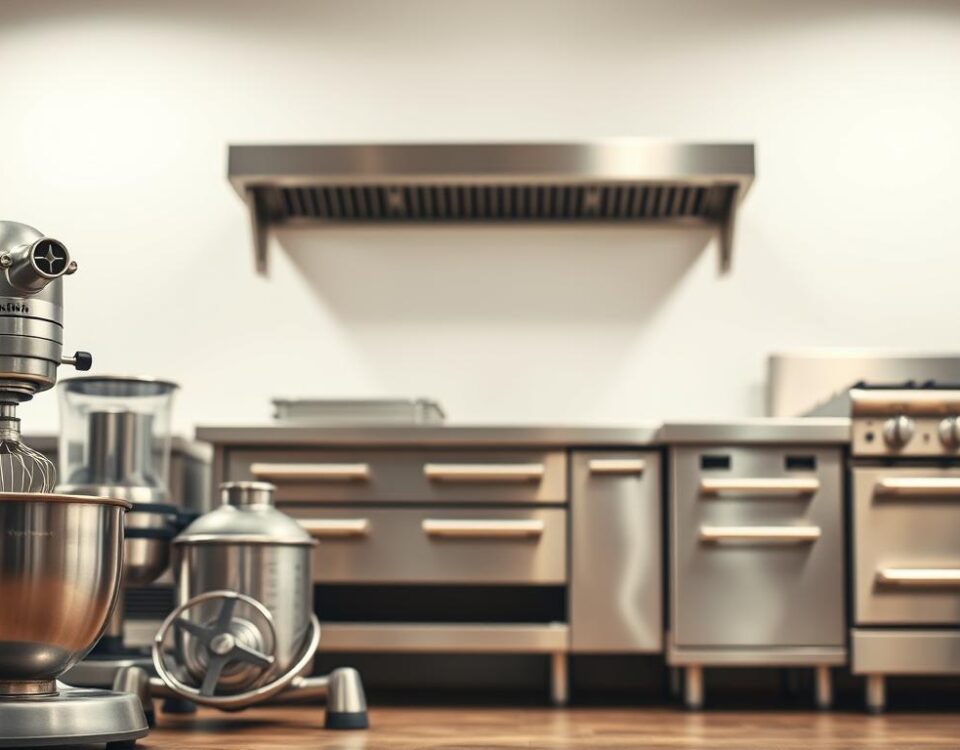
Restaurant Tech Stack 2025: 10 Tools for Streamlined Operations
August 10, 2025
How to Open a Restaurant on a Tight Budget
August 11, 2025Opening a restaurant is a dream for many, but the reality of high startup costs can be daunting. With expenses ranging from $100,000 to $2 million, securing the right business funding is crucial. Did you know that a significant number of restaurants fail due to undercapitalization? This highlights the importance of understanding your financing options.
Choosing the right loans or credit options can be the difference between success and failure. As a business owner, navigating the complex landscape of financing can be overwhelming, but it’s essential to find the best fit for your specific needs. So, how do you determine which restaurant financing path aligns with your goals and financial situation?
Key Takeaways
- Understand the various financing options available for restaurants.
- Learn how to determine the right loan or credit for your business needs.
- Discover the importance of credit score in securing financing.
- Explore alternative funding sources beyond traditional bank loans.
- Gain insights into the eligibility requirements for different financing options.
Understanding Restaurant Financing Needs
Understanding your restaurant’s financing needs is crucial for making informed decisions about your business’s future. Restaurant financing can be used for various purposes, including covering essential operating costs and funding expansion or renovation projects.
Common Reasons Restaurants Need Financing
Restaurants often require financing to manage various aspects of their business. Common scenarios include opening a new location, renovating an existing space, purchasing equipment, or managing cash flow during slow seasons. Restaurant financing can help cover essential costs such as payroll, inventory, marketing, and unexpected expenses.
- Payroll and staffing costs
- Inventory and supplies
- Remodeling or renovation expenses
- Marketing and advertising initiatives
- New equipment purchases or upgrades
Determining How Much Funding You Need
Accurately determining your funding needs is vital before applying for financing. To do this, you’ll need to create a detailed budget that accounts for all potential expenses. This includes calculating startup costs for new restaurants, such as lease deposits, equipment purchases, initial inventory, and working capital.
| Expense Category | Estimated Cost |
|---|---|
| Lease Deposit | $5,000 |
| Equipment Purchases | $30,000 |
| Initial Inventory | $10,000 |
| Working Capital | $20,000 |
| Total | $65,000 |
Building a financial buffer for unexpected costs is also essential. By understanding your specific financing needs, you can choose the most appropriate funding option for your restaurant business.
Evaluating Your Restaurant’s Financial Position
Before diving into restaurant financing options, it’s crucial to assess your business’s current financial standing. This evaluation will not only help you understand your eligibility for financing but also enable you to make informed decisions about your restaurant’s future.
Assessing Your Credit Score and Financial History
Your credit score plays a significant role in determining your eligibility for restaurant financing. Most lenders require a minimum personal credit score of 550 to 640, depending on the loan type. It’s essential to review both your personal and business credit scores to understand where you stand. A good credit score can qualify you for better financing terms and lower interest rates. To improve your credit score, focus on paying down existing debt, including restaurant financing or credit card balances, and ensure timely payments on all accounts.
Tips for improving your credit score:
- Check your credit report for errors and dispute them if necessary.
- Pay down outstanding debt to reduce your debt-to-income ratio.
- Make timely payments on all accounts.
- Avoid applying for too much credit in a short period.
Preparing Your Business Documentation
To apply for restaurant financing, you’ll need to prepare comprehensive business documentation. This includes organizing your business banking records, such as 3-6 months of bank statements, to verify your cash flow and revenue consistency. Additionally, you’ll need to provide tax returns, profit and loss statements, and balance sheets. Having a solid business plan that demonstrates your restaurant’s potential for success and ability to repay the loan is also crucial.

Key financial metrics that lenders will evaluate include your debt-to-income ratio and debt service coverage ratio. Ensuring that your financial documentation is accurate and well-organized will make the application process smoother and increase your chances of approval. Your restaurant’s time in business and revenue history also significantly affect your financing options and eligibility.
Traditional Bank Loans for Restaurants

When it comes to financing a restaurant, traditional bank loans are often the first option considered by established businesses. A standard business loan from a traditional bank is typically referred to as a “brick and mortar” loan. To qualify, you’ll need an excellent credit score and may be required to provide collateral to secure the loan.
Qualification Requirements
To qualify for a traditional bank loan, restaurant owners must meet specific requirements. These typically include a minimum credit score, a certain number of years in business, and annual revenue thresholds. Banks also consider the overall financial health and history of the business.
The documentation required for a traditional bank loan application is extensive and may include financial statements, tax returns, and business plans. Ensuring that your business documentation is in order is crucial for a successful application.
Pros and Cons of Traditional Financing
Traditional bank loans offer several advantages, including lower interest rates, longer repayment terms, and access to larger loan amounts. However, the qualification process can be challenging, especially for new or high-risk businesses.
For established restaurants with a strong financial history, traditional bank loans can be an attractive financing option. It’s essential to weigh the pros and cons and consider your business’s specific needs and circumstances before making a decision.
SBA Loans: A Popular Restaurant Financing Option

The Small Business Administration (SBA) offers loan programs that are particularly beneficial for restaurant businesses. These loans are attractive due to their favorable terms, such as lower down payments and longer repayment periods, making them a viable option for restaurant owners seeking financing.
Types of SBA Loans for Restaurants
The SBA provides several loan programs tailored to different business needs. For restaurants, the primary options include:
- 7(a) loans: Up to $5 million for general business purposes, with terms up to 300 months.
- CDC/504 loans: Up to $5.5 million for commercial real estate or heavy equipment purchases, with terms up to 300 months.
- Microloans: Up to $50,000 for general business purposes, with terms up to 84 months.
Each loan type is suited for different situations, and choosing the right one depends on your specific business needs.
Application Process and Requirements
To apply for an SBA loan, you’ll need to meet certain requirements, including a good credit score, typically 680 or higher, and a solid business plan. The application process involves working with an SBA-approved lender, which can make the process more complex and time-consuming than other financing options.
Having a strong business plan and demonstrating industry experience can significantly improve your chances of approval. The SBA loan guarantee also plays a crucial role in reducing risk for lenders, making approval more likely for restaurant businesses.
Understanding the nuances of SBA loans and carefully preparing your application are key steps in securing the financing your restaurant needs.
Business Lines of Credit for Restaurants

Restaurant financing options are varied, but a business line of credit stands out for its flexibility. This financing tool allows restaurant owners to access a set amount of funds as needed, providing a financial safety net during lean times or when unexpected expenses arise.
How Lines of Credit Work for Restaurants
A business line of credit gives restaurant owners the ability to draw funds as needed, up to a predetermined limit. The key benefit is that interest is only paid on the amount drawn, not on the entire credit limit. This makes it an attractive option for managing cash flow and covering unexpected expenses.
The revolving nature of a line of credit means that as the borrowed amount is repaid, the credit becomes available again, providing ongoing financial flexibility. This is particularly useful for restaurants that experience seasonal fluctuations in revenue.
When to Choose This Option
A business line of credit is particularly beneficial for restaurants facing seasonal cash flow challenges or those undergoing renovations that often exceed budget. It’s also a good option for covering payroll during slow periods or for making strategic investments in the business.
To qualify, restaurant owners typically need to demonstrate a good credit history and provide financial documentation. Lenders may offer secured or unsecured lines of credit, with the latter often requiring a stronger financial profile.
Managing a business line of credit responsibly is crucial. By doing so, restaurant owners can maintain a good standing with lenders and preserve this financing option for future needs.
Equipment Financing for Restaurant Owners

Equipment financing is a crucial aspect of restaurant management, allowing owners to acquire the tools they need without breaking the bank. As a restaurant owner, you’re likely aware that having the right equipment is essential for delivering high-quality food and maintaining a smooth operation.
Using Equipment as Collateral
One of the key benefits of equipment financing is that the equipment itself can be used as collateral. This means that lenders can offer more favorable terms, as the risk is mitigated by the value of the equipment. Equipment loans typically finance up to 80% of the equipment’s value, although some lenders offer 100% financing with no down payment required.
Using equipment as collateral makes this financing option more accessible to restaurant owners with limited credit history or lower credit scores. However, it’s essential to understand that if you default on the loan, the lender can seize the equipment.
Lease vs. Purchase Considerations
When it comes to equipment financing, restaurant owners have two primary options: leasing or purchasing. Leasing allows for lower upfront costs and the flexibility to upgrade equipment more frequently, which can be beneficial for businesses that want to stay up-to-date with the latest technology.
On the other hand, purchasing equipment outright can provide long-term cost savings and ownership benefits. It’s crucial to weigh the pros and cons of each option, considering factors such as tax implications, maintenance responsibilities, and long-term costs, to decide which is best for your restaurant.
By understanding the terms and conditions of equipment financing, restaurant owners can make informed decisions that support their business goals and financial stability.
Merchant Cash Advances for Quick Restaurant Funding

In the competitive restaurant industry, securing funding rapidly is essential, and merchant cash advances offer a swift, if expensive, financing option. A merchant cash advance (MCA) is an advance on your future credit card sales, providing immediate access to capital.
How Merchant Cash Advances Work
A merchant cash advance is structured as an advance against future sales, typically credit card transactions. The lender provides a lump sum upfront, and repayments are made directly from your daily credit card sales. This financing option is particularly appealing to restaurants due to their high volume of credit card transactions.
The qualification requirements for an MCA are generally less stringent than traditional loans, as the lender’s primary concern is the volume of your credit card sales rather than your credit score. This makes MCAs accessible to businesses that might not qualify for conventional financing.
Benefits and Drawbacks to Consider
The primary benefit of a merchant cash advance is the quick access to funds without the need for collateral. Repayments are also flexible, as they are directly tied to your daily sales. However, the significant drawback is the high cost associated with MCAs, with interest rates sometimes reaching as high as 300% APR.
It’s crucial to carefully evaluate the terms of any MCA offer, understanding the factor rate and calculating the true cost of the advance. Having a clear plan for using the MCA funds to generate additional revenue is essential to offset the high cost.
While MCAs can be expensive, they might be appropriate in emergency situations or when other financing options are not available. Carefully considering the benefits and drawbacks is essential to making an informed decision.
Alternative Restaurant Financing Options

When traditional financing routes are not available, restaurant owners can explore alternative financing options to fund their business ventures. These alternatives can provide the necessary capital to launch, expand, or renovate a restaurant.
Crowdfunding for Restaurants
Crowdfunding is an increasingly popular method for restaurants to raise capital. It allows owners to fund their projects without relying on traditional loans, and it doesn’t require repayment if certain conditions are met. Platforms like Kickstarter, Indiegogo, and GoFundMe enable restaurants to create campaigns that attract backers and build a community around their brand.
Crowdfunding models vary, including reward-based, equity-based, and donation-based campaigns. The choice of model depends on the restaurant’s concept, goals, and target audience. A successful crowdfunding campaign requires a compelling pitch, attractive rewards, and effective marketing.
Investor Financing
Working with investors is a common way for independent restaurants to secure funding. Investors can be fellow restaurateurs, former employers, family members, friends, or high-net-worth individuals known as “Angel Investors.” They provide capital in exchange for future profits, making it a viable option for restaurants with a solid business plan.
However, taking on investors means sharing profits and potentially some control over business decisions. It’s essential for restaurant owners to weigh the pros and cons before deciding on investor financing.
Restaurant Grants and Specialty Programs
Various grant programs and specialty financing options are available for restaurant businesses, particularly those owned by minorities, women, or veterans. These programs can offer favorable terms, such as low-interest rates or no repayment requirements.
Restaurant owners can also explore financing programs offered by industry associations, restaurant supply companies, and POS system providers. Combining multiple alternative financing sources can help fully fund a restaurant project.
By exploring these alternative financing options, restaurant owners can find the capital they need to succeed. Whether through crowdfunding, investor financing, or specialty programs, there are various paths to securing the necessary funds.
Comparing Restaurant Financing Options
To secure the best financing for your restaurant, you need to evaluate various choices. With multiple financing options available, comparing them is crucial to finding the one that best suits your business needs.
Interest Rates and Fee Structures
Interest rates and fees can significantly impact the total cost of your loan. Traditional bank loans and SBA loans often offer more favorable interest rates, ranging from 4% to 8% APR, but may have higher fees. In contrast, merchant cash advances typically come with higher interest rates, sometimes exceeding 20% APR, but often have fewer fees.
For instance, a business line of credit might have a variable interest rate, while a short-term loan could have a fixed rate. Understanding these nuances is key to making an informed decision.
Repayment Terms and Schedules
Repayment terms vary significantly across different financing options. Traditional loans usually require monthly payments over several years, while merchant cash advances often demand daily or weekly payments.
For seasonal restaurants, a flexible repayment schedule that aligns with their cash flow can be particularly beneficial. It’s essential to consider how different repayment schedules might impact your business’s financial health.
Approval Time and Funding Speed
The time it takes to get approved and receive funding is another critical factor. Merchant cash advances are known for their quick approval and same-day funding, making them ideal for urgent needs. In contrast, SBA loans can take weeks or even months to process.
Understanding the approval timelines and funding speeds can help you choose the financing option that best fits your business’s immediate needs.
| Financing Option | Min. Credit Score | Max. Loan Amount | Term Length | Key Benefits |
|---|---|---|---|---|
| Business Line of Credit | 550 | — | — | Revolving credit, only pay interest on withdrawals |
| Short-term Loan | 550 | $5 million | 6-24 months | A lump sum with no collateral required |
| Equipment Loan | 550 | Value of equipment | Varies | High approval rate; equipment is the collateral |
| SBA Loan | 640 | $5 million | 5-25 years | Guaranteed by the SBA up to 75% or 85%, depending on the amount |
By comparing these financing options based on interest rates, repayment terms, and approval times, you can make a more informed decision that aligns with your restaurant’s financial situation and goals.
Best Practices for Managing Restaurant Cash Flow
A well-managed cash flow is the backbone of a thriving restaurant business. As a restaurant owner, it’s essential to understand that maintaining a healthy cash flow is crucial for covering daily expenses, managing seasonal fluctuations, and making strategic decisions about growth and investments.
Seasonal Planning Strategies
To manage cash flow effectively, restaurants must plan for seasonal variations in revenue. During busy seasons, it’s wise to save a portion of the profits to cover fixed costs during slower periods. This strategic saving can help mitigate the impact of seasonal dips and ensure continuous operation.
Additionally, leveraging financing options such as a business line of credit can provide the necessary flexibility to manage cash flow during fluctuations. By having access to funds when needed, restaurants can cover unexpected expenses or capitalize on opportunities without disrupting their cash flow.
Emergency Fund Considerations
Establishing an emergency fund is a critical component of cash flow management for restaurants. This fund serves as a safety net for unexpected expenses, such as equipment failures or sudden repairs, allowing the business to continue operating smoothly.
To determine the appropriate size of the emergency fund, restaurant owners should consider their monthly expenses and potential risks. A general rule of thumb is to save enough to cover 3-6 months of operating expenses.
| Cash Flow Management Strategies | Benefits |
|---|---|
| Save during busy seasons | Covers fixed costs during slow periods |
| Use a business line of credit | Provides flexibility during fluctuations |
| Establish an emergency fund | Covers unexpected expenses |

By implementing these strategies and maintaining a keen eye on cash flow, restaurant owners can navigate the challenges of the industry with confidence. Effective cash flow management not only ensures the day-to-day operation of the restaurant but also positions it for long-term success.
How to Apply for Restaurant Financing
Applying for restaurant financing can be a daunting task, but with the right preparation, you can increase your chances of approval. To start, it’s essential to determine your business loan needs and choose the type of financing that matches your restaurant’s goals.
Preparation is Key
Before applying, review key eligibility factors, including your restaurant’s time in business, annual revenue, and credit score. Checking both personal and business credit scores ensures accuracy and helps you understand your financial standing.

Step-by-Step Application Process
The application process involves several steps:
- Complete the online application
- Submit required documentation, such as recent bank statements, business licenses, and financial statements
- Provide detailed business information, including leases and licenses
When researching lenders, consider factors like interest rates, fees, collateral requirements, and repayment terms. A well-prepared business plan can also strengthen your application.
| Documentation | Description |
|---|---|
| Bank Statements | Recent statements showing financial stability |
| Business Licenses | Proof of legal operation |
| Financial Statements | Detailed records of income and expenses |
Common Application Mistakes to Avoid
Restaurant owners often make mistakes when applying for financing, such as incomplete applications or lack of preparation. To avoid these pitfalls, ensure you have all necessary documentation and a clear understanding of your financial situation.
“A well-prepared business plan and accurate financial documentation are crucial for a successful restaurant financing application.”
By following these steps and avoiding common mistakes, you can improve your chances of securing the restaurant financing you need.
Making the Right Restaurant Financing Decision
As you navigate the complex world of restaurant financing, it’s essential to consider your options carefully. With various financing options available, selecting the best one for your business requires careful consideration of factors like growth stage, credit profile, and funding needs.
To make an informed decision, it’s crucial to evaluate your credit score and financial history. A good credit score can help you qualify for better business loan options with competitive interest rates. At Clarify Capital, we specialize in restaurant financing, offering business loans with rates starting at 7% and a fast, hassle-free application process.
When choosing a financing option, consider both short-term needs and long-term financial health. Create a financing strategy that evolves with your restaurant business as it grows and matures. Building relationships with lenders even before you need financing can also be beneficial.
By considering these factors and consulting with financial advisors or accountants, you can make a confident, informed decision that supports your restaurant’s growth and success. With the right financing in place, you can focus on delivering great food and service to your customers.
FAQ
What are my credit score requirements to qualify for a business loan?
Most lenders require a minimum credit score of 600 to 650 to qualify for a business loan. However, some alternative lenders may consider applicants with lower credit scores. I recommend checking my credit report and score before applying.
How long does it take to get approved for a merchant cash advance?
Approval times for a merchant cash advance can be as quick as a few days, and in some cases, even on the same day. The lender will review my business’s credit card sales history and other factors to determine eligibility.
Can I use equipment financing to purchase new equipment for my business?
Yes, equipment financing allows me to use the equipment itself as collateral to secure the loan. This can be a great way to acquire new equipment while spreading the cost over time.
What is the difference between a business line of credit and a loan?
A business line of credit provides me with a revolving credit limit that I can draw upon as needed, whereas a loan is a one-time lump sum payment. A business line of credit offers more flexibility in managing my cash flow.
Are SBA loans a good financing option for my business?
SBA loans can be a great financing option because they offer more favorable terms, such as lower interest rates and longer repayment periods, compared to traditional loans. However, the application process can be lengthy and requires meeting specific eligibility criteria.
How do I determine the right interest rate for my business loan?
The interest rate for my business loan will depend on various factors, including my credit score, loan amount, and repayment term. I should compare rates from different lenders to find the best deal for my business.
Can I use a business plan to secure financing for my business?
Yes, a well-written business plan can help demonstrate my business’s potential and viability to lenders, making it more likely to secure financing. I should ensure my plan is comprehensive and includes financial projections.



